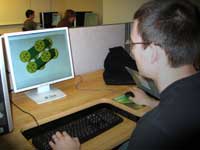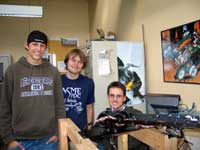Good Samaritan Goes Micro
Building on the success of past years, Good Samaritan, an urban search-and-rescue robot designed to locate and identify humans trapped in disaster areas, is going mini... and micro. The product of senior capstone students in mechanical engineering, the '07/08 Good Samaritan is designed to detect and identify victims in unstructured environments and transmit information to rescue crews prior to rescue efforts.
The RoboCup team, led by mechanical engineering instructor Carl Kaiser, set high standards for this year's team, previously placing second in the national RoboCup Urban Search and Rescue (USAR) Competition and fourth in the world championship. Designed to develop technology to overcome the challenges involved in search and rescue applications, the RoboCup competitions provide a forum for objective evaluation of robotic implementations in representative environments and also promote collaborations among researchers from other universities.
Originally equipped with a thermal imager that uses infrared light to detect body heat, a microphone to detect human voice and visible light camera for navigation, the Good Samaritan is reaching new levels - and sizes - this year. Aside from components, team members Jay Waterman, Michael Soroka, Scott Klein, David Lehman, Levi Mitchell, and Dan Kesterson are fine-tuning a mini version of the Good Samaritan to tackle smaller confined spaces that even rescue dogs cannot enter. The innovation of past senior design students, the Mini prototype, half the size of the original, measures only about 12 inches on a side.
 |
 |
 |
In addition to size, several new components have been added to the original design. Allowing the robot to access spaces previously obstructed, an arm with six degrees of freedom will provide a means to maneuver over and around obstacles including stairs, extreme steps and rubble fields. The robot will also be equipped with a SLAM (Simultaneous Localization and Mapping) system using LADAR or laser-based radar. Another adjustment from previous models is the redesigned communication and computational system. This system allows more data to be gathered, processed and transmitted using less power and space, and allows for multiple robots to be controlled from a single point.
Also addressing real-world scenarios, senior design students Tyler Brown, Shane Brisendine, Christopher Maunder, Matthew Ellis, Matthew Smith, Daniel Ross, and Matthew Wilkson are designing the newest member of the Good Samaritan family, the Micro. With the opening to many voids in the World Trade Center rubble measuring less than six inches across, the Good Samaritan Micro, which is half the size of the Mini, will be the smallest self-contained robot ever designed for search and rescue applications such as 9/11, and will revolutionize the competitive field.
Good Samaritan and Good Samaritan-Mini will compete in Spring 2008 as an integrated team at the RoboCup National Championship in Atlanta, Georgia. A strong finish at the RoboCup World Championships in Bremen, Germany, in 2006 will likely ensure the teams a spot in this year's international competition to be held in Suzhou, China next summer.
During competition, robots must search for humans in a simulated collapsed building and report locations to "rescue workers" outside the competition field autonomously. Lifelike mannequins placed throughout the field are equipped with actuated joints and thermal signatures, which imitate body temperature. Mannequins also emit carbon dioxide as if breathing and make noises simulating someone trapped in rubble.
One of only a handful of undergraduate teams competing, the Good Samaritan team works with significantly less budget than fellow competitors, focusing on good system design and a minimalist approach, a method that pays big dividends. With limited time to showcase the robots and their components, simplicity equates to more reliable, faster and easy-to-drive robots — serious competitive advantages. These skills are also valuable to industry and are a large part of the reason why local robotics companies hire many mechanical senior design students working on these projects. In particular Wolf Robotics and SA Robotics are major financial sponsors of the projects.
"The fact that seniors from CSU are competing against paid graduate students from other universities, and competing very well, is a testament to the quality of the students here at CSU and the hard work that they are willing to put in," said Kaiser.
Additional Information
For more information on the senior design teams and ways to donate please visit www.engr.colostate.edu/ramlab.